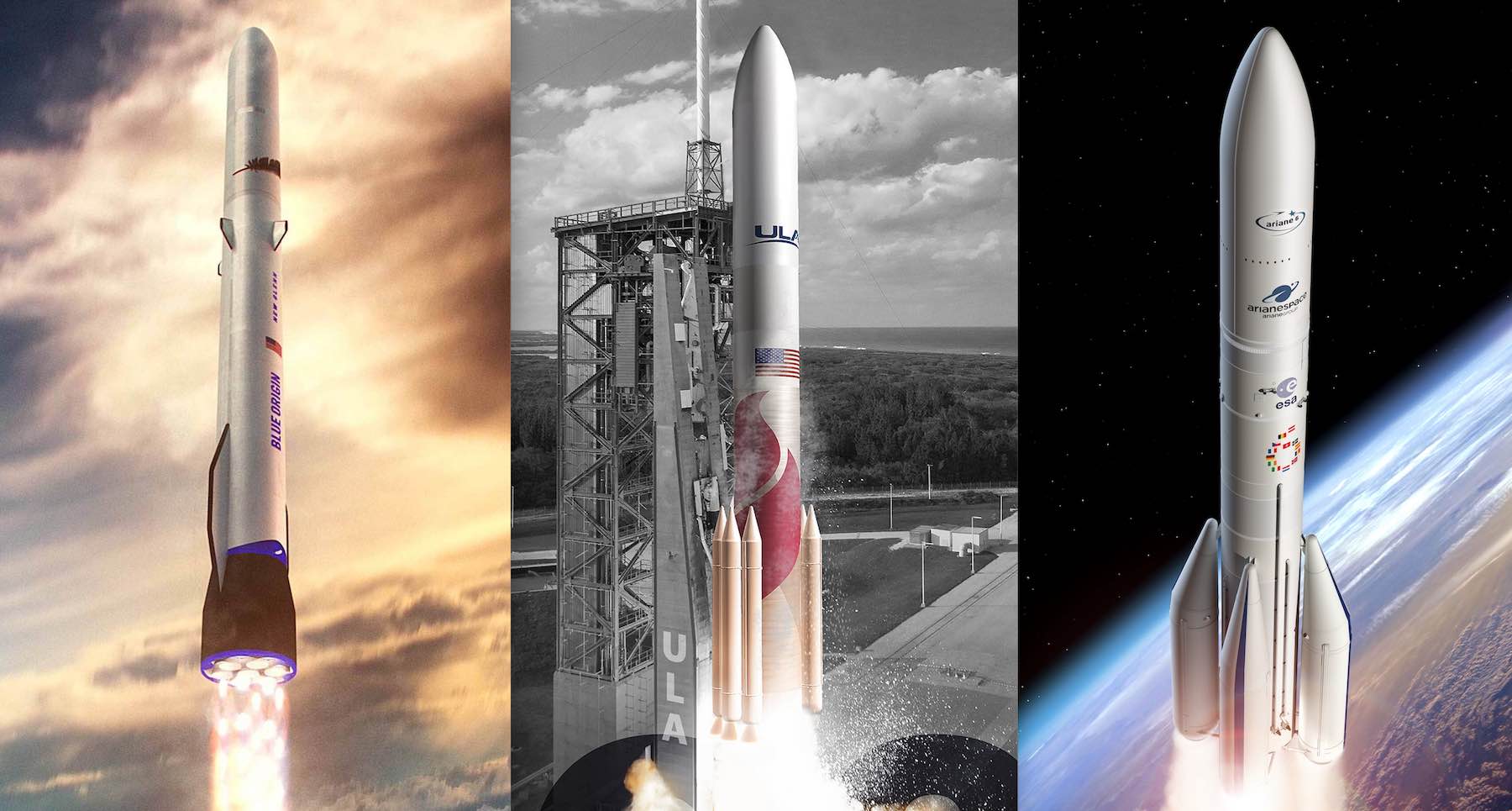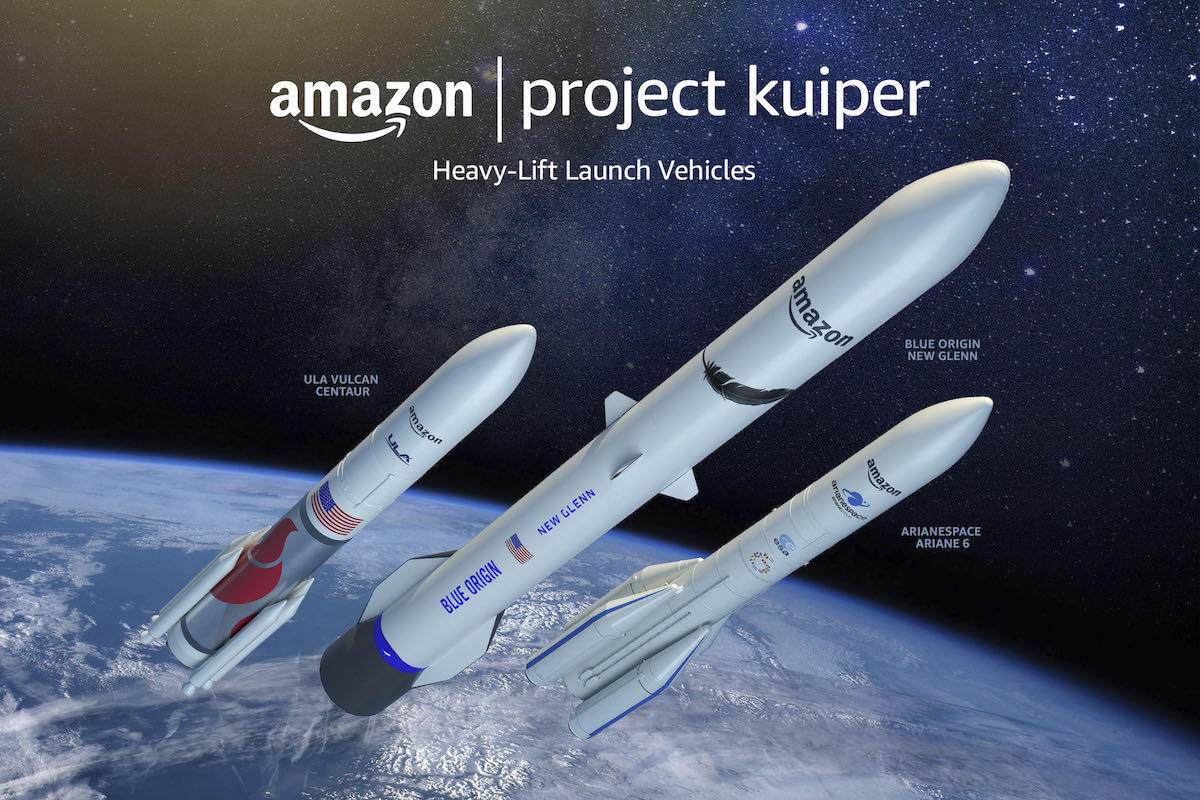
Amazon announced the largest commercial launch deal in history Tuesday, revealing agreements for up to 83 missions to deploy thousands of internet satellites on United Launch Alliance’s Vulcan Centaur rocket, Arianespace’s Ariane 6, and Blue Origin’s New Glenn vehicle.
The agreements solidify the commercial business cases for all three rockets, more than doubling the backlogs for Vulcan Centaur, Ariane 6, and New Glenn rockets before any of them have ever flown.
Amazon’s Kuiper network, similar in concept to SpaceX’s Starlink constellation and the OneWeb satellite fleet, will provide low-latency Ka-band broadband internet connectivity to customers between 56 degrees north and 56 degrees south latitude.
The multibillion-dollar deals with ULA, Arianespace, and Blue Origin represent the largest commercial procurement of launch vehicles in history. Financial specifics were not disclosed, and officials did not say when the launches will begin.
“Project Kuiper will provide fast, affordable broadband to tens of millions of customers in unserved and underserved communities around the world,” said Dave Limp, senior vice president for Amazon devices and services. “We still have lots of work ahead, but the team has continued to hit milestone after milestone across every aspect of our satellite system.
“These launch agreements reflect our incredible commitment and belief in Project Kuiper, and we’re proud to be working with such an impressive lineup of partners to deliver on our mission,” Limp said in a statement.
Half of the Kuiper network’s 3,236 satellites must be launched by mid-2026 for Amazon to maintain network authorization from the Federal Communications Commission. None of the satellites have launched so far, but Amazon plans to launch the first two Kuiper prototype spacecraft on a launch of ABL Space Systems’ new RS1 rocket before the end of this year.
Amazon announced last April a contract with ULA to launch some of its early Kuiper satellites on nine Atlas 5 rocket missions. ULA is retiring the Atlas 5 in favor of the next-generation Vulcan Centaur rocket.
The new agreement announced Tuesday covers 38 launches on ULA’s Vulcan Centaur rocket. ULA said it plans to upgrade and expand its launch infrastructure at Cape Canaveral Space Force Station to support the high flight rate needed to fulfill the Amazon contract.
The upgrades include a second, dedicated mobile launch platform for the Kuiper missions, and modifying ULA’s Spaceflight Processing and Operations Center at Cape Canaveral to serve as a second Vertical Integration Facility to stack and integrated rockets before rollout to the launch pad.
“This agreement marks the beginning of an exciting new era for ULA and for the entire U.S. launch industry,” said Tory Bruno, president and CEO of ULA, a 50-50 joint venture between Boeing and Lockheed Martin. “With a total of 47 launches between our Atlas and Vulcan vehicles, we are proud to launch the majority of this important constellation.
“It will support hundreds of jobs, especially in places like Alabama, Colorado and Florida, and Amazon’s investments in launch infrastructure and capability upgrades will benefit both commercial and government customers,” Bruno said.
The Kuiper missions will use the heaviest version of the Vulcan Centaur with six strap-on solid rocket boosters, according to Bruno.

Amazon also committed to 18 flights with Arianespace, using the new European Ariane 6 rocket launched from Kourou, French Guiana.
“This contract, the largest we’ve ever signed, is a great moment in Arianespace’s history,” said said Stéphane Israël, CEO of Arianespace, in a statement “We are honored to be given a significant role to play in the deployment of Amazon’s Project Kuiper, which aims to connect tens of millions of people to the internet.
Israël said the contract with Amazon “will build on the European innovative spirit, industrial might, and years of experience, and it is a major win for the European launcher industry. That Amazon has chosen the Ariane 6 to do the job is a matter of tremendous pride for us and a great vote of confidence in our new launch vehicle.”
All 18 of Arianespace’s flights for Amazon will use the Ariane 64 rocket configuration with four solid rocket boosters clustered around the main cryogenic stage. Sixteen of the missions will utilize uprated versions of the Ariane 64 with higher power solid-fueled boosters.
Blue Origin, established by Amazon founder Jeff Bezos, won an initial tranche of 12 missions for Project Kuiper using the heavy-lift New Glenn rocket. Amazon secured options for up to 15 additional New Glenn missions.
“We’re honored to support Amazon’s ambitious mission to provide reliable, affordable broadband to unserved and underserved communities around the world through New Glenn and our BE-4 engines,” said Jarrett Jones, senior vice president of the New Glenn program at Blue Origin. “New Glenn’s seven-meter fairing offers unprecedented mass and volume capabilities, providing Project Kuiper maximum launch flexibility.”
Blue Origin will also build the BE-4 engines that power ULA’s Vulcan Centaur rocket. The Vulcan booster uses two BE-4 engines, augmented by varying numbers of strap-on solid rockets, while the New Glenn will be powered by seven BE-4 engines, with no solid rocket boosters.
The Kuiper program operates as a separate entity from Blue Origin, meaning Bezos’s space company had to bid for Kuiper launches in a competitive procurement process.
The New Glenn missions will lift off from Space Launch Complex 36 at Cape Canaveral.
Officials from each of the Kuiper launch providers said their rockets can carry dozens of Amazon internet satellites on a single flight. The Ariane 64 rocket will launch between 35 and 40 satellites per mission, the Vulcan Centaur can accommodate 45 Kuiper satellites per launch, and the New Glenn can haul 61 per launch.
Those numbers, coupled with the previous Kuiper launch deal for nine ULA Atlas 5 rockets, mean Amazon has secured enough launch capacity to deploy all 3,236 satellites in its satellite network, and then some.
None of the rockets contracted by Amazon have flown yet. ULA and Arianespace say their teams are on track to launch the first Vulcan Centaur and Ariane 6 test flights before the end of this year. The first launch of Blue Origin’s New Glenn rocket has been delayed since 2020, and a company executive last month rule out the possibility launching the first New Glenn demonstration flight this year.
SpaceX’s Falcon rocket family, the most-flown commercial space launcher type in recent years, did not win any of launch services agreements Amazon announced Wednesday. Bezos and Musk are two of the richest people in the world, and their space companies are rivals in the commercial space industry.
The Starlink internet network developed by SpaceX is also a competitor to Project Kuiper.
Last month, SpaceX and OneWeb — also rivals — announced an agreement to begin launching OneWeb’s internet satellites on SpaceX Falcon 9 rockets. OneWeb planned to launch the rest of its first-generation satellite fleet on Russian Soyuz rockets through a contract arranged with Arianespace, but commercial and international Soyuz missions have been suspended after Russia’s invasion of Ukraine.
So far, OneWeb has launched 428 of its planned first-generation constellation of 648 satellites on 13 Soyuz rockets. SpaceX has launched 2,335 Starlink satellite on its reusable Falcon 9 rockets.
Amazon is getting a late start on its constellation, but the company is developing its spacecraft in house.
“There are now more than 1,000 people at Amazon working on Project Kuiper, and the team continues to make progress as it approaches a full, production-ready deployment — finalizing its high-performance satellite design, producing a compact, affordable customer terminal, and deploying a secure, reliable communications network that connects satellites to customers and infrastructure on the ground,” Amazon said.
Email the author.
Follow Stephen Clark on Twitter: @StephenClark1.
from Spaceflight Now https://ift.tt/byhZ0wu
via World Space Info







0 comments:
Post a Comment